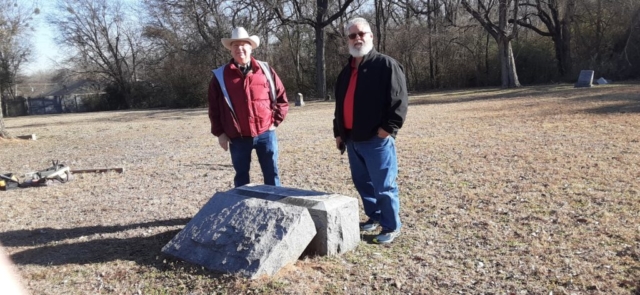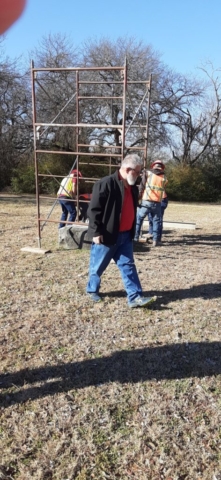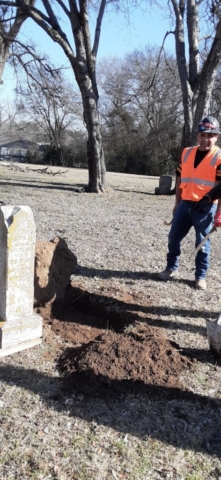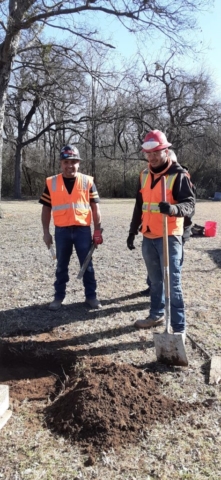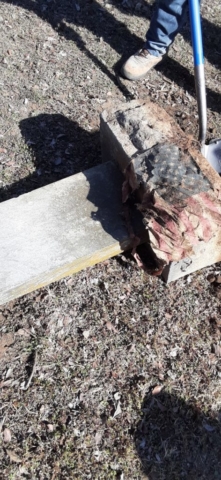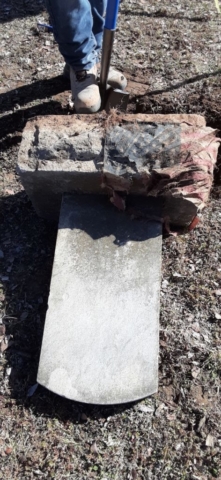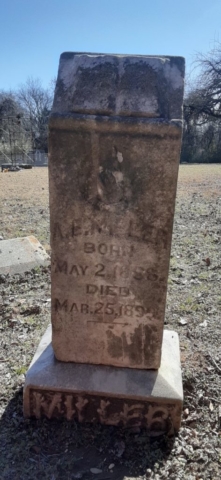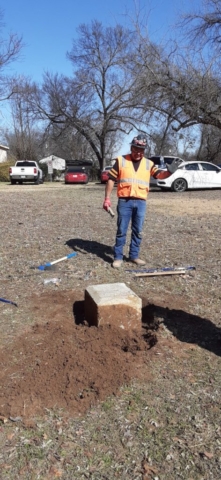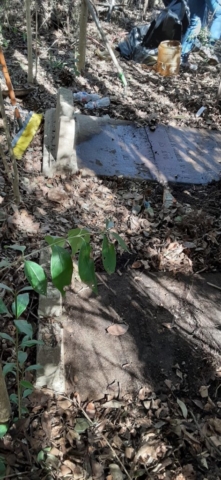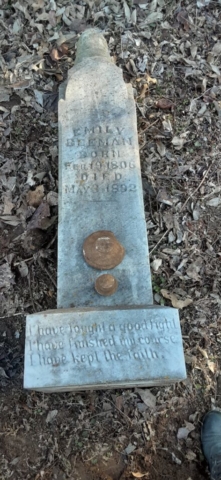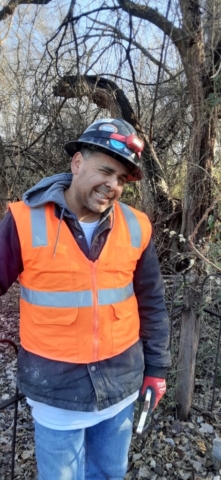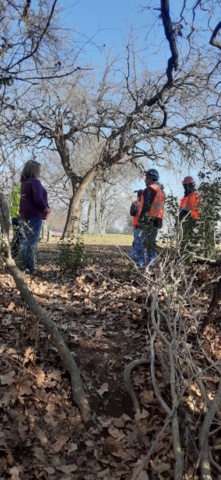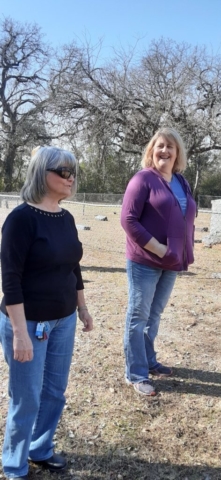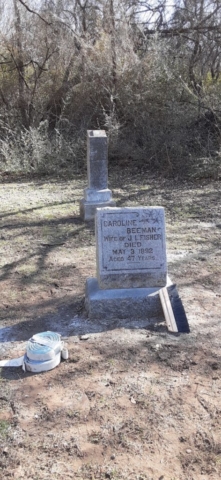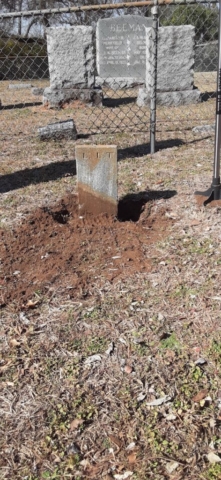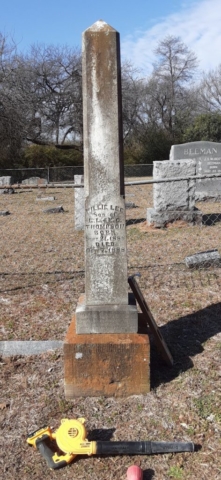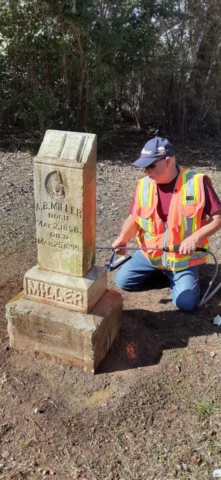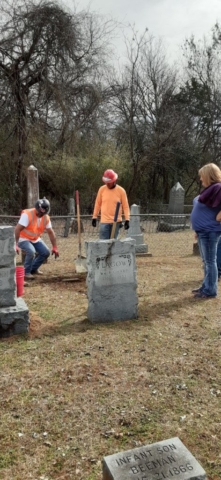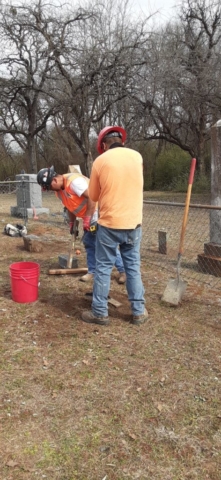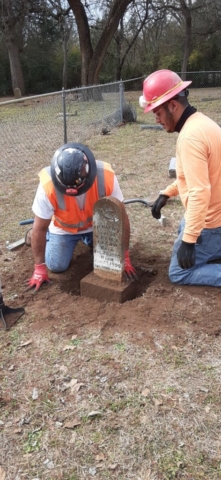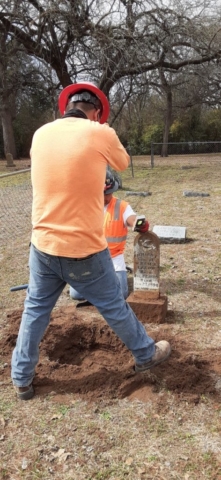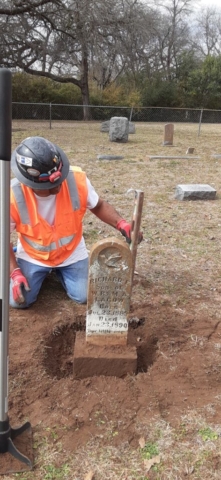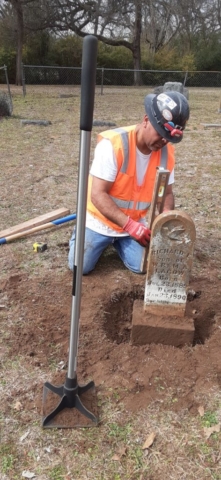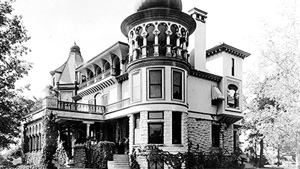By Frances James (1922 – 2019)
The Beeman Cemetery is south of Haskell Avenue, off Dolphin Road. Go east on Minga and turn right on (Gault) Pepper to the end. There is no street address for the cemetery. It is behind the Shearith Israel Cemetery on Dolphin Road. John Beeman was quoted as saying the site for the cemetery was the “prettiest place on the farm.” This is where he was buried in 1856. The nearly one and one-half acres of the cemetery are on the west side of White Rock Creek.
When John and Emily Beeman – the first family to come to what is now Dallas and remain, left Bird’s Fort in Robinson County and came to the east side of the Trinity River to Nacogdoches County in 1843, this is where they settled. John Beeman thought this land near the creek was public domain and available and started to develop it only to discover that it was a section of the bounty land given to Thomas Lagow by Mirabeau B. Lamar, President of the Republic of Texas in 1841. During the Texas Revolution Thomas Lagow had recruited young men arriving in Texas, equipped them with horses and guns, and delivered them to Sam Houston’s army. For this, the Republic of Texas gave Thomas Lagow the over 4000 acre Lagow League in then Nacogdoches County (Patent No. 645). The League was surveyed by Warren Ferris.
When contacted by John Beeman, Thomas Lagow made an agreement with him to sell John a section (640 acres) of land for $1.00 an acre in October 1844. Unfortunately Thomas Lagow died in Houston County in January 1845 before the sale was completed. His wife had died in 1844 and his will stated that he was “on the bed of affliction.” Thomas named William T. Sadler as the executor of this will and his handshake agreement with Beeman was finalized in 1850.
This portion of the Republic of Texas became available when the War with Mexico was over in 1836. Pioneers in many areas of American heard about the fertile land with adequate water that was now available for settlement. Signs were posted on their last home that said “Gone to Texas” as entire families packed up and headed south. The first Peters Colony contract to “introduce emigrants within the Republic” was signed in January 1841.
The Beeman family left Greene County, Illinois and started moving south in 1840. They stopped in Red River County, Texas to plant a crop of corn and to wait for Emily to deliver he ninth child, a son, John Scott Winfield (Scott) Beeman, in May 1841. While there they heard about the promise of land if they went to help build Bird’s Fort on the west side of the Three Forks of the Trinity River area. Volunteers were recruited and some of the Beeman family agreed to help build the fort in what is now Tarrant County. Assistance with food for these short term rangers was to have been supplied by the Republic of Texas.
Much of Texas was not available for settlement due to the Indian problems that were still taking place. The Indians were not happy with the Bird’s Fort project so they burned off the trees and grass surrounding the fort and the game and wildlife disappeared. This caused the food supply to become even more critical to the families in the Fort. It was very cold in December when three men left the Fort in an attempt to replenish the food supply. While cutting down a tree to get the honey in a large honeycomb they were ambushed by a small party of Indians. Hamp Rattan was killed and was one of the few white people that had ever been reported killed by the Indians in this part of Texas. Solomon Silkwood, the husband of Patsy Hunnicutt, died two days after Christmas 1841 from exposure after the thwarted attempt to get food. Alexander Webb was the third man and he survived.
John Neely Bryan, who had settled on the east bank of the Trinity River, heard about the plight of the families at the Fort and went over there to persuade them to come to the area where he was camping. He told them there was adequate wild life for hunting. After over three months at Bird’s Fort, John and his wife Emily Hunnicutt Beeman and several of their relatives and children were among those who loaded up their wagons and came to the east side of the Trinity River in Apirl 1842. Margaret Beeman, one of the John Beeman’s daughters, married John Neely Bryan the next year!
At the same time Mabel Gilbert and his pregnant wife came to Dallas by water. They floated down the Trinity River in a dugout made by a slave and Gilbert who had been a steamboat commander. Others also left Bird’s Fort and came to the east side of the Three Forks of the Trinity River to get land in the Peters Colony.
The first known burial in the Beeman Cemetery was that of Holland Coffee Bryan, the firstborn son of Margaret Beeman Bryan and John Neely Bryan in 1845. The baby was named for the owner of Coffee’s Station on the Red River where so many of the pioneers coming to Texas stopped for supplies before coming down Preston Road to Dallas.
There is a wrought iron fence surrounding Emily and John Beeman’s graves that also encloses the other children of Margaret and John Neely Bryan who died as infants. William Beeman and his wife, Martha Dye, are also buried in this plot, enclosed by the fence, with his parents. There is a Republic of Texas Medallion for John Beeman presented by the Daughters of the Republic of Texas. When Emily Beeman died in 1892 she was living with her daughter Caroline Fisher in the DeSoto area.
Family lore is that the Beemans brought one slave with them, Jack, and he is buried in the cemetery with a flat rock for his marker. For many years when Emily came to bring flowers for John’s grave she would also bring flowers for Jack’s grave.
There is a fenced area for Scott Beeman, the son born in 1841. Within this fenced area are the graves of Scott, his wife Elizabeth Merrifield Beeman and five or their children who did not live to adulthood. How Scott and Elizabeth Merrifield met and married would be interesting to know since the Merrifield family lived in what is now Oak Cliff and owned many acres of land on the west side of the area. The Lagow family intermarried with these other families and eight Lagow descendants are also included in this area.
Outside of this fence on the east side of Scott’s section are the head stones for his sister, Elizabeth Beeman Harter Bryan Cumby and several of her children. Her first husband was Henry Harter of Canton, Ohio who came to the Three Forks area in 1843 with a herd of cattle he and James J. Beeman had brought. He and Elizabeth Beeman were married and had one little girl, Louisiana, who was born in 1845. Family lore is that Harter died and was buried at sea! Widow Elizabeth then married widower James Bracken Bryan the older brother of John Neely Bryan in 1849. Bryan had a little girl Louise, born in 1839 who Elizabeth mothered along with their son, Sam. Family lore is that James left on a “white mule” to go gold mining in 1849 and was never heard from again. (Some believe he married in California and raised a family.)
Elizabeth divorced James in 1853 and married for the third time, William Cumby. Cumby had been married before and was the father of several children and helped provide for Elizabeth’s children. They are both buried at this cemetery. Several of the children are also buried in this cemetery.
There is a low wrought iron fenced area with eight curbed graves that was for the Shaffner family. George Shaffner (1841-1918) was born in St. Louis, Missouri. In an article out of the St. Louis Republican on August 20, 1862 it states that forty-nine prisoners had been captured in a guerrilla camp a short distance from St. Louis. The prisoners were confined at the Gratiot Street Prison. George Shaffner was on the list of the forty-nine captured. The article stated that these were probably new recruits getting ready to head south and join General Sterling Price.
George served during the Civil War in the Missouri Cavalry under Colonel Caleb Dorsy’s Regiment. He was captured twice and the first time he was traded at Vicksburg, Mississippi. The second time he was captured in Arkansas and charged with carrying contraband in the company of Joe Leddy who was in possession of a Rebel mail pouch. George was tried by a US Army Court Martial court and sentenced to hard labor in the US penitentiary until the end of the war. Family lore was that he was a spy for General William Lewis Cabell who suffered defeat and imprisonment at the invasion of Missouri in 1864.
After the war George came to Dallas, Texas and met and married Sara Cara Leitus Beeman in 1874. She was teh daughter of William and Martha Dye Beeman. Of their eight children, number seven was Sara Cara, (1859-1935).
George and Cara had eight children: Mary 1875, Frank 1877, Velma 1879, Mabel 1881, Flora 1884, Myrltl 1886, Virginia 1889 and Martha 1895.
Several of the Shaffner family members are buried at the Beeman Cemetery – Frank, Flora, Martha, Mabel. There is also a son-in-law and a grandchild in these eight graves enclosed by teh short fence.
George was listed as an electrician in the 1915 Dallas City Directory and they lived at 405 Exposition in east Dallas near Fair Park. Cara and George had a granddaughter named Cara Letis who married William Kershaw. She was one of the trustees of the Beeman Cemetery Association in the 1940s when the Association was active.
Caroline Beeman and Isaac Fisher are on the east side of the cemetery. Other Fisher family members are in the Cox Cemetery that is near the Fisher settlement close to White Rock Lake.
On the west side of Emily and John’s lot is another fenced area. This plot contains the graves of the Sypert and Thompson family. James and Nancy Thompson Sypert came to Dallas in 1852 and raised their family. Their daughter Laura married G. T. Hawpe in 1876. Hawpe was the son of Electa and Trezevant C. Hawpe, who was a Confederate veteran, Mayor of Dallas, and Sheriff of Dallas County. He was murdered on the courthouse steps in an argument with a friend while trying to collect the money from the sale of a hog.
In 1939 Ira Beeman, Scott’s son, drew up a design for the Beeman Cemetery with separate plots for some of the Beeman’s sons and daughters. The design was for a lane down the middle and a circle drive around the entire cemetery. Not all of the Beeman descendants lived long enough nor did they all stay in the Dallas area to utilize their plots.
Buried in this cemetery near White Rock Creek were neighbors and friends. Many children and grandchildren, some without markers, are buried in this cemetery. Descendants of this large family have intermarried with descendants of other early settlers of Dallas County. In 1976 for the Bicentennial the Dallas Park Department took over the maintenance of this cemetery and three others. The metes and bounds were incorrect so the Park Department refused to maintain the east side where John and Emily and others are buried. The family decided to donate the funds to maintain this narrow strip privately. After about ten years of this dual maintenance the Park Department decided that this was foolish and they now maintain the entire site. The families provide the funds to attend to any special needs that may arise from time to time.
The Beeman Cemetery is registered as a Historic Texas Cemetery and also has a Texas Historical Marker in place.
Frances James, “Dallas County History – From the Ground Up, Book II”
2022 Work Days at Beeman Cemtery


